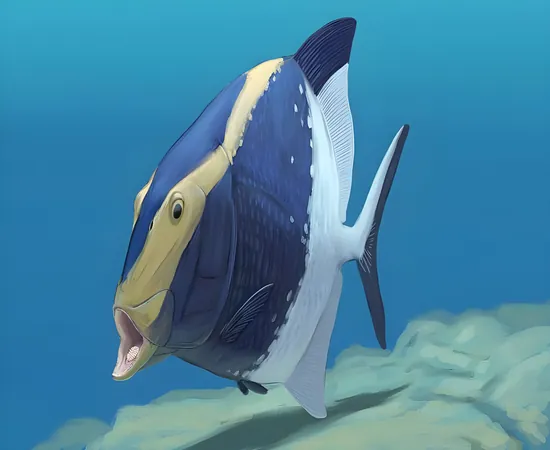
Revolutionary Discovery: 310-Million-Year-Old Fish Reveals Ancient Feeding Innovations
2025-09-04
Author: Michael
Fossils That Rewrite History
In a stunning discovery, scientists have unearthed a fossilized fish in the Carboniferous rocks of Staffordshire, dating back 310 million years. This ancient ray-finned fish, named **Platysomus parvulus**, boasts a fascinating feature: a primitive 'tongue bite' mechanism that revolutionized how fish consumed their prey.
A Game-Changing Feeding Mechanism
This groundbreaking fish utilized specialized teeth on both the top and bottom of its mouth, enabling it to crush hard prey like shells and insects. Unlike most fish that depended solely on their jaws, **Platysomus** developed an innovative dual chewing surface, enhancing its feeding capabilities.
Tracing the Evolution of Feeding Strategies
Today's fish, such as trout and bonefish, exhibit similar biting techniques, but **Platysomus** pushes this innovation back by an astonishing 150 million years. This demonstrates early evolutionary experimentation in feeding methods crucial for survival and success in changing ecosystems.
What the Fossil Reveals
The fossil uncovers a lower tooth plate composed of multiple segments opposing a narrow upper plate, both adorned with pointed teeth. This suggests an early stage in the evolution of tongue bites, highlighting primitive methods of prey processing. While less efficient than later crushing plates, this mechanism allowed the fish to grip and pierce delicate shells.
Gradual Specialization in Feeding Systems
As evolution progressed, fish like the bobasatraniids developed advanced crushing plates capable of tackling tougher prey, demonstrating a significant step toward specialization in feeding systems.
Insights into Fish Evolution After Mass Extinction
According to lead researcher Professor Sam Giles from the University of Birmingham, this discovery helps illuminate fish evolution after the **End-Devonian Mass Extinction**, when many species vanished.
Following this catastrophe, fish began diversifying in body shapes and feeding strategies, adapting to survive in a competitive environment.
Not Just a Simple Fish
Unlike later species that evolved away from jaws, **Platysomus parvulus** still employed them alongside its unique tongue bite, serving as an evolutionary link between ancient jawed fish and those that relied purely on advanced tongue-biting mechanisms.
Diverse Feeding Innovations in the Carboniferous
The Carboniferous period was a time of rapid anatomical innovation among ray-finned fishes. **Platysomus** emerged after lineages had already developed specialized structures for hard food, showcasing the gradual diversification of feeding strategies.
The Impact of Platysomus on Evolutionary Understanding
This remarkable finding suggests that ancient fish were pioneering various feeding strategies much earlier than previously thought. The research outlines how evolution is a gradual and intricate process, combining traditional traits with emerging innovations that enabled survival and adaptation.
Published in the journal *Biology Letters*, this study not only reveals a crucial evolutionary step but also redefines our understanding of how modern fish lineages evolved. **Platysomus parvulus** stands as a testament to the wonders of natural selection and the gradual march of evolution.









 Brasil (PT)
Brasil (PT)
 Canada (EN)
Canada (EN)
 Chile (ES)
Chile (ES)
 Česko (CS)
Česko (CS)
 대한민국 (KO)
대한민국 (KO)
 España (ES)
España (ES)
 France (FR)
France (FR)
 Hong Kong (EN)
Hong Kong (EN)
 Italia (IT)
Italia (IT)
 日本 (JA)
日本 (JA)
 Magyarország (HU)
Magyarország (HU)
 Norge (NO)
Norge (NO)
 Polska (PL)
Polska (PL)
 Schweiz (DE)
Schweiz (DE)
 Singapore (EN)
Singapore (EN)
 Sverige (SV)
Sverige (SV)
 Suomi (FI)
Suomi (FI)
 Türkiye (TR)
Türkiye (TR)
 الإمارات العربية المتحدة (AR)
الإمارات العربية المتحدة (AR)